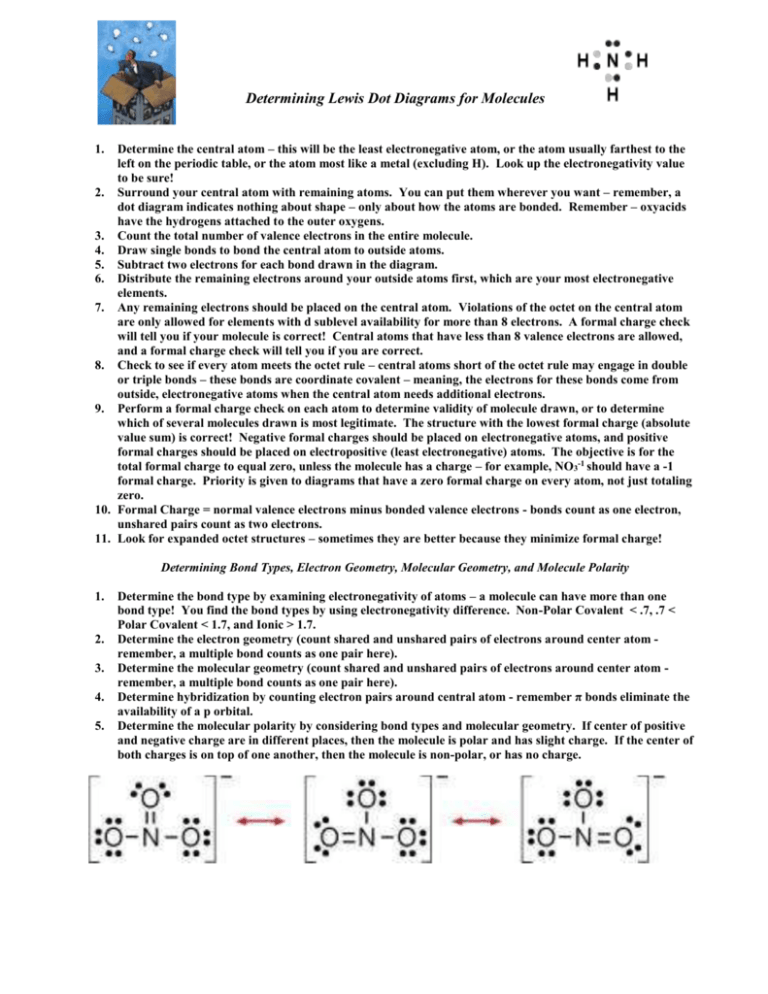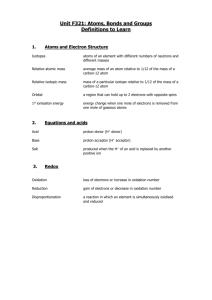Determining Lewis Dot Diagrams for Molecules
advertisement

Determining Lewis Dot Diagrams for Molecules 1. Determine the central atom – this will be the least electronegative atom, or the atom usually farthest to the left on the periodic table, or the atom most like a metal (excluding H). Look up the electronegativity value to be sure! 2. Surround your central atom with remaining atoms. You can put them wherever you want – remember, a dot diagram indicates nothing about shape – only about how the atoms are bonded. Remember – oxyacids have the hydrogens attached to the outer oxygens. 3. Count the total number of valence electrons in the entire molecule. 4. Draw single bonds to bond the central atom to outside atoms. 5. Subtract two electrons for each bond drawn in the diagram. 6. Distribute the remaining electrons around your outside atoms first, which are your most electronegative elements. 7. Any remaining electrons should be placed on the central atom. Violations of the octet on the central atom are only allowed for elements with d sublevel availability for more than 8 electrons. A formal charge check will tell you if your molecule is correct! Central atoms that have less than 8 valence electrons are allowed, and a formal charge check will tell you if you are correct. 8. Check to see if every atom meets the octet rule – central atoms short of the octet rule may engage in double or triple bonds – these bonds are coordinate covalent – meaning, the electrons for these bonds come from outside, electronegative atoms when the central atom needs additional electrons. 9. Perform a formal charge check on each atom to determine validity of molecule drawn, or to determine which of several molecules drawn is most legitimate. The structure with the lowest formal charge (absolute value sum) is correct! Negative formal charges should be placed on electronegative atoms, and positive formal charges should be placed on electropositive (least electronegative) atoms. The objective is for the total formal charge to equal zero, unless the molecule has a charge – for example, NO3-1 should have a -1 formal charge. Priority is given to diagrams that have a zero formal charge on every atom, not just totaling zero. 10. Formal Charge = normal valence electrons minus bonded valence electrons - bonds count as one electron, unshared pairs count as two electrons. 11. Look for expanded octet structures – sometimes they are better because they minimize formal charge! Determining Bond Types, Electron Geometry, Molecular Geometry, and Molecule Polarity 1. 2. 3. 4. 5. Determine the bond type by examining electronegativity of atoms – a molecule can have more than one bond type! You find the bond types by using electronegativity difference. Non-Polar Covalent < .7, .7 < Polar Covalent < 1.7, and Ionic > 1.7. Determine the electron geometry (count shared and unshared pairs of electrons around center atom remember, a multiple bond counts as one pair here). Determine the molecular geometry (count shared and unshared pairs of electrons around center atom remember, a multiple bond counts as one pair here). Determine hybridization by counting electron pairs around central atom - remember π bonds eliminate the availability of a p orbital. Determine the molecular polarity by considering bond types and molecular geometry. If center of positive and negative charge are in different places, then the molecule is polar and has slight charge. If the center of both charges is on top of one another, then the molecule is non-polar, or has no charge.







